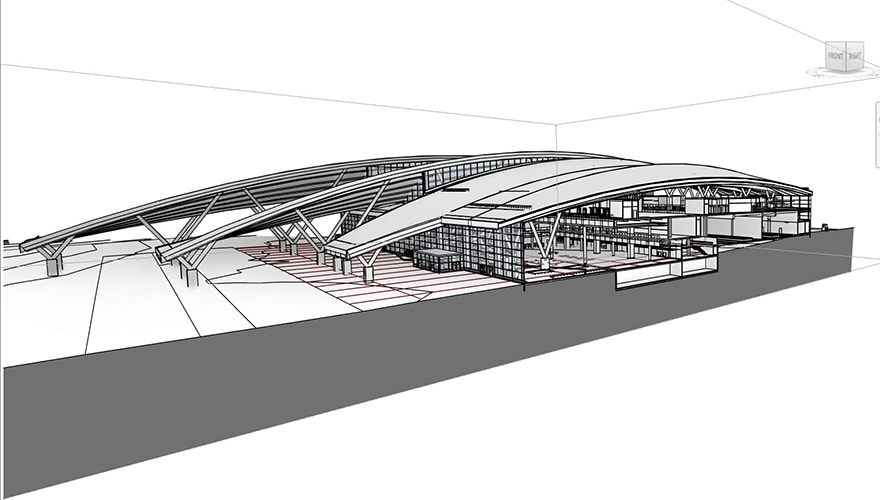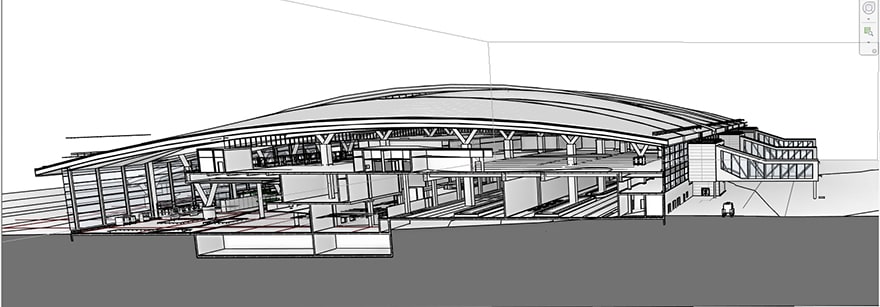- Client: Airports of the Regions
- Lead Contractor: Twelve Architects (lead designer)
- BIM Tools: Revit, ArchiCAD
The US$943m international and domestic airport terminal, located in Rostov province, southern Russia, will meet an initial demand for five million passengers each year.
It relocates the existing Rostov-on-Don Airport in the city, which is unable to expand due to residential development at each ends of the runway, to a site 30 miles north.
The project will be delivered across two phases as part of a wider transport development programme, the first 50,600 sq m phase is slated for completion in time for the 2018 Fifa World Cup. The second phase, due to begin in around 10 years, will expand it to around 100,000 sq m.
Twelve Architects’ design for the terminal is inspired by the analogy of the airport as a “sky-bridge” that connects cities and countries together, visually expressed in a roof formed from a series of elegant arches.
The use of BIM was driven by the architect, having seen time and design efficiency benefits when designing the Diamond Department of Engineering building for the University of Sheffield in the UK.
Alex Bitus, head of transport at Twelve Architects, told BIM+: “There was no requirement from the client [part of the Renova Group, the largest airport holding company in Russia] to use BIM as they were not aware of the advantages. The use of BIM in Russia is not widespread and is normally driven by architects and consultants, who understand the time and resource savings and resulting financial benefits. Clients are more worried about the end product than the process and BIM is not being regulated here as it is in the UK.”

The airport is designed with a roof formed of elegant arches
BIM was implemented to improve design coordination and software was utilised by key design consultants for architecture, structure and M&E services, based variously in Germany and Russia.
The basic equivalent of a BIM Execution Plan was drawn up to define modelling targets against a timeline, and a training plan was also devised to bring consultants up to speed with the software.
However, the lack of a dedicated BIM Manager, appointed by the client to set up the project, coordinate the team and resolve any issues, was an obstacle to fully effective collaboration, says Bitus.
Read related articles
Russia follows UK lead in making BIM compulsory
Russian government sets up pilot projects to increase BIM usage
Twelve developed a central federated BIM model in Revit, viewable by different consultants, combining geometry and data from its models produced in Graphisoft ArchiCAD and Revit.
“ArchiCAD is more popular in Russia, having been used there for the past 15-20 years, whereas Autodesk is just beginning to market Revit there,” says Bitus. “The two packages can speak to each other, but some data was lost in translation and it was not always a smooth process.”
The structural model, developed in AutoCAD, was essentially a 3D object sitting in the central Revit model with different properties applied by Twelve. In addition, Bitus says ArchiCAD is better set up to meet the Russian authorities’ strict regulations on design, which even define how drawings must be printed, and specific line widths.

The biggest benefits BIM were improved clash detection and more efficient implementation of the design process.
The biggest benefits of using BIM on the project were improved clash detection and more efficient implementation of the design process.
The project also provided an opportunity to get staff in the consulting team up to speed with the technology in preparation for future projects in the region. “It takes an entire project to learn the BIM process, it is not a matter of weeks or months – having gone through all the design stages you can then be confident that a person is proficient,” says Bitus.
The terminal building is organised on an orthogonal and repetitive 16x16m grid, designed to easily accommodate future expansion in phase two. Completing the first phase in BIM could prove an important foot in the door for Twelve Architects and its consultants when tendering for the expansion, potentially reducing the time and resources needed to develop a new model from scratch.
“In future we will always aim to explain the benefits of BIM to clients so it is more of a driver for them to get all the consultants involved,” says Bitus. “They need to understand how it can be used during the later stages when the airport is in operation, when maintenance is required, or when there are plans for expansion,” he concludes.
The use of BIM in Russia is not widespread and is normally driven by architects and consultants, who understand the time and resource savings and resulting financial benefits. Clients are more worried about the end product than the process and BIM is not being regulated here as it is in the UK.– Alex Bitus, head of transport, Twelve Architects











